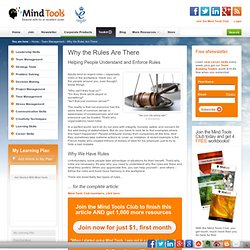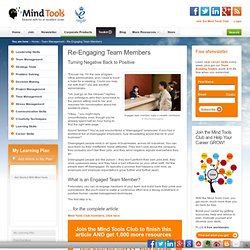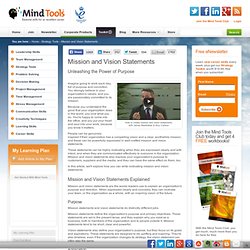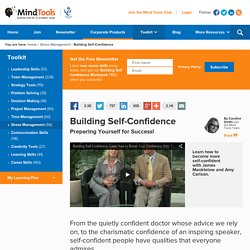

Blake Mouton Managerial Grid - Leadership Training from MindTools. Balancing Task- and People-Oriented Leadership © iStockphotoanthonyjhall When your boss puts you in charge of organizing the company Christmas party, what do you do first?

Do you develop a time line and start assigning tasks, or do you think about who would prefer to do what, and try to schedule around their needs? When the planning starts to fall behind schedule, what is your first reaction? Do you chase everyone to get back on track, or do you ease off a bit, recognizing that everyone is busy just doing his/her job, let alone the extra tasks you’ve assigned? Your answers to these types of questions can reveal a great deal about your personal leadership style. Neither preference is right or wrong, just as no one type of leadership style is best for all situations.
A popular framework for thinking about a leader’s ‘task versus person’ orientation was developed by Robert Blake and Jane Mouton in the early 1960s. Understanding the Model Figure 1 – The Blake Mouton Managerial Grid Note: Nine Things Successful People Do Differently - Heidi Grant Halvorson - Harvard Business Review - StumbleUpon. Learn more about the science of success with Heidi Grant Halvorson’s HBR Single, based on this blog post.

Why have you been so successful in reaching some of your goals, but not others? If you aren’t sure, you are far from alone in your confusion. It turns out that even brilliant, highly accomplished people are pretty lousy when it comes to understanding why they succeed or fail. The intuitive answer — that you are born predisposed to certain talents and lacking in others — is really just one small piece of the puzzle. In fact, decades of research on achievement suggests that successful people reach their goals not simply because of who they are, but more often because of what they do. 1. To seize the moment, decide when and where you will take each action you want to take, in advance. 3.
Fortunately, decades of research suggest that the belief in fixed ability is completely wrong — abilities of all kinds are profoundly malleable. 7. 8. 9. Management by Objectives (MBO) - Team Management Training from MindTools. Aligning Objectives With Organizational Goals Learn how to align people's actions with your organization's goals. © iStockphoto/danleap In many organizations, it's hard to remember a time when non-managerial employees were kept in the dark about strategy.

We're often reminded about the corporate mission statement, we have strategy meetings where the "big picture" is revealed to us, and we're even invited to participate in some business decisions. We're also kept aware of how our day-to-day activities contribute to corporate goals. This type of managing hasn't been around forever. About the Tool Peter Drucker developed MBO, and published it in his 1954 book, "The Practice of Management.
" The idea may have become a victim of its own success; it became such an integral part of modern business practice that it may no longer have seemed worthy of comment. Advantages and Disadvantages Using Management by Objectives with your team offers several benefits. Why the Rules are There - Team Management Training from MindTools. Helping People Understand and Enforce Rules "Get your rule-setting right.

" © iStockphoto Adults tend to resent rules – especially rules in the workplace. Have you, or the people around you, ever thought these things: "Why can't they trust us? " The reality is that not everyone has the same level of common sense or awareness of consequences, and not everyone can be trusted. In a perfect world, we'd all do our jobs with integrity, honesty, safety, and concern for the well-being of stakeholders. Why We Have Rules Unfortunately, some people take advantage of situations for their benefit. There are essentially two types of rules... ... for the complete article: Mind Tools Club members, click here. Join the Mind Tools Club to finish this article AND get 1,000 more resources Join now for just $1, first month. Re-Engaging Team Members - Team Management Training from MindTools. Turning Negative Back to Positive Engaged team members make a valuable contribution. © iStockphoto/dgilder "Excuse me, I'm the new program office administrator, and I need to book a hotel for a meeting.

Mission Statements and Vision Statements - Leadership Techniques from MindTools. Unleashing the Power of Purpose How to create mission and vision statements, with James Manktelow & Amy Carlson.

Imagine going to work each day, full of purpose and conviction. You strongly believe in your organization's values, and you are passionately committed to its mission. Because you understand the good that your organization does in the world, you love what you do. You're happy to come into the office, and you put your heart and soul into your work, because you know it matters. People can be genuinely inspired if their organization has a compelling vision and a clear, worthwhile mission; and these can be powerfully expressed in well-crafted mission and vision statements. These statements can be highly motivating when they are expressed clearly and with intent, and when they are communicated effectively to everyone in the organization. Building Self-Confidence - Prepare yourself for success - Stress management skills from Mind Tools.
Preparing Yourself for Success!

Learn how to become more self-confident with James Manktelow and Amy Carlson. From the quietly confident doctor whose advice we rely on, to the charismatic confidence of an inspiring speaker, self-confident people have qualities that everyone admires. Self-confidence is extremely important in almost every aspect of our lives, yet so many people struggle to find it. Sadly, this can be a vicious circle: people who lack self-confidence can find it difficult to become successful. After all, most people are reluctant to back a project that's being pitched by someone who was nervous, fumbling, and overly apologetic. On the other hand, you might be persuaded by someone who speaks clearly, who holds his or her head high, who answers questions assuredly, and who readily admits when he or she does not know something.
Why Preparing in Advance is Priceless: How MasterCard CEO Ajay Banga Planned Ahead for His New Leadership Role. Ajay Banga did a particularly good job at Master Card at embracing and leveraging his Fuzzy Front End (the time between the acceptance of the job and his start date). Many leaders fall into the trap of believing that leadership begins on day one of a new job, but Banga’s actions are a good example of how leaders can use the time before then to get a head start in order to increase their chance of success. Making the Move to MasterCard CEO Ajay’s transition from Citibank to MasterCard began even before the official announcement in June 2009 that he would join the company that summer. Arguably, his whole initial role as COO was one large Fuzzy Front End before he took over as CEO on July 1, 2010. Ajay recently explained to me that this was all part of the three-stage plan created by his predecessor, Bob Selander, and the board: Stage 1) Ajay as COO reporting to Bob; Stage 2) Ajay as CEO with Bob still around; and Stage 3) Ajay as CEO with Bob not there. : get a half-step ahead of the curve.
Don't Lead Until You Have Earned the Right to Lead in a New Job.